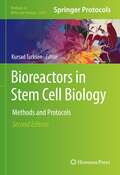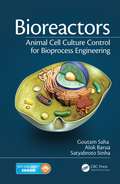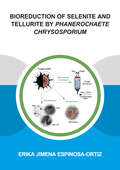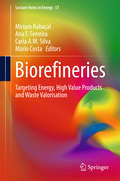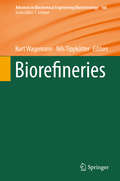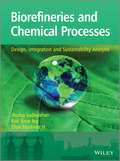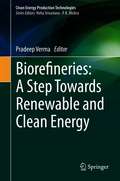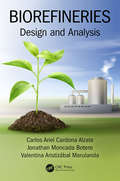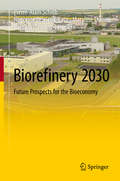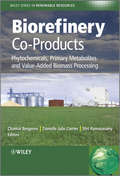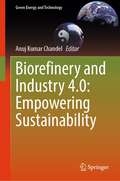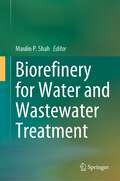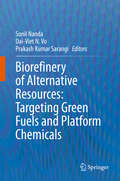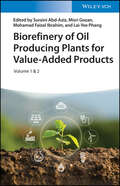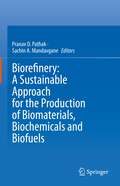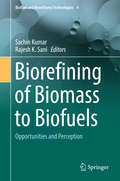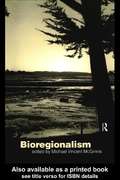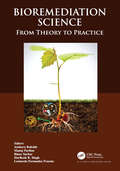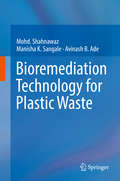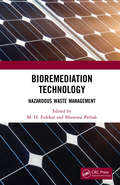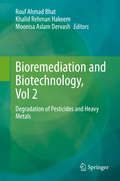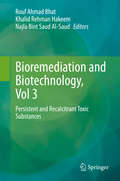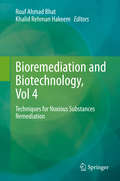- Table View
- List View
Bioreactors in Stem Cell Biology: Methods and Protocols (Methods in Molecular Biology #2436)
by Kursad TurksenThis new edition brings together some of the latest developments and protocols reflecting the rapidity with which bioreactor technologies are advancing and being applied. Given that the use of bioreactors in cell biology is becoming more commonplace as attempts are made to scale-up production of various types of cells for regenerative medicine and pharmaceutical purposes, this volume provides practical guidance for navigating research projects. Written for the highly successful Methods in Molecular Biology series, chapters include introductions to their respective topics, lists of the necessary materials and reagents, step-by-step, readily reproducible laboratory protocols, and tips on troubleshooting and avoiding known pitfalls. Authoritative and cutting-edge, Bioreactors in Stem Cell Biology: Methods and Protocols, Second Edition will benefit both established investigators and newcomers to this dynamic area of study.
Bioreactors: Animal Cell Culture Control for Bioprocess Engineering
by Goutam Saha Alok Barua Satyabroto SinhaBioreactors: Animal Cell Culture Control for Bioprocess Engineering presents the design, fabrication, and control of a new type of bioreactor meant especially for animal cell line culture. The new bioreactor, called the "see-saw bioreactor," is ideal for the growth of cells with a sensitive membrane. The see-saw bioreactor derives its name from its principle of operation in which liquid columns in either limb of the reactor alternately go up and down. The working volume of the reactor is small, to within 15 L. However, it can easily be scaled up for large production in volume of cell mass in the drug and pharmaceutical industries.The authors describe the principle of operation of the see-saw bioreactor and how to automatically control the bioprocess. They discuss different control strategies as well as the thorough experimental research they conducted on this prototype bioreactor in which they applied a time delay control for yield maximization.To give you a complete understanding of the design and development of the see-saw bioreactor, the authors cover the mathematical model they use to describe the kinetics of fermentation, the genetic algorithms used for deriving the optimal time trajectories of the bioprocess variables, and the corresponding control inputs for maximizing the product yield. One chapter is devoted to the application of time delay control. Following a description of the bioreactor’s working setup in the laboratory, the authors sum up their investigation and define the future scope of work in terms of design, control, and software sensors.
Bioreduction of Selenite and Tellurite by Phanerochaete Chrysosporium (IHE Delft PhD Thesis Series)
by Erika Jimena Espinosa-OrtizSelenium (Se) and tellurium (Te) are metalloids of commercial interest due to their physicochemical properties. The water soluble oxyanions of these elements (selenite, selenate, tellurite and tellurate) exhibit high toxicities; hence, their release in the environment is of great concern. This study demonstrates the potential use of fungi as Se- and Te-reducing organisms. The response of Phanerochaete chrysosporium to the presence of selenite and tellurite was evaluated, as well as its potential application in wastewater treatment and production of nanoparticles. Growth stress and morphological changes were induced in P. chrysosoporium when exposed to selenite and tellurite. Synthesis of Se0 and Te0 nanoparticles entrapped in the fungal biomass was observed, as well as the formation of unique Se0-Te0 nanocomposites when the fungus was cultivated concurrently with Se and Te. The response of P. chrysosporium to selenite exposure was investigated in different modes of fungal growth (pellets and biofilm). A bioprocess for selenite removal and Se0 nanoparticles recovery using an up-flow fungal pelleted reactor was developed. 70% selenite removal (10 mg Se L-1 d-1) was achieved under continuous mode. The use of Se0 nanoparticles immobilized in P. chrysosporium pellets as a new sorbent material for the removal of heavy metals from wastewater was demonstrated.
Biorefineries
by Miriam Rabaçal Ana F. Ferreira Mário Costa Carla A. SilvaThis book addresses the potential of the transformation of biomass into a wide range of marketable products, and examines the biological, biochemical, physical and thermal processing of biomass into products such as fuels, power, heat, feeds, chemicals and materials. Respective chapters explore various topics including biomass characterization, biomass pre-conditioning and sustainability analysis, aspects that are supplemented by a global overview of their implementation in current pilot bio-refineries. Providing a valuable resource to energy engineers, chemical engineers, biotechnologists and economists, this book will also be of great interest to students and policymakers.
Biorefineries (Advances in Biochemical Engineering/Biotechnology #166)
by Kurt Wagemann Nils TippkötterThis book offers a comprehensive review on biomass resources, examples of biorefineries and corresponding products. The first part of this book covers topics such as different biorefinery resources from agriculture, wood processing residues and transport logistics of plant biomass. In the second part, expert contributors present biorefinery concepts of different biomass feedstocks, including vegetable-oils, sugarcane, starch, lignocellulose and microalgae. Readers will find here a summary of the syngas utilization and the bio-oil characterization and potential use as an alternative renewable fuel and source for chemical feedstocks. Particular attention is also given to the anaerobic digestion-based and Organosolv biorefineries. The last part of the book examines relevant products and components such as alcohols, hydrocarbons, bioplastics and lignin, and offers a sustainability evaluation of biorefineries.
Biorefineries and Chemical Processes
by Elias Martinez Hernandez Jhuma Sadhukhan Kok Siew NgAs the range of feedstocks, process technologies and products expand, biorefineries will become increasingly complex manufacturing systems. Biorefineries and Chemical Processes: Design, Integration and Sustainability Analysis presents process modelling and integration, and whole system life cycle analysis tools for the synthesis, design, operation and sustainable development of biorefinery and chemical processes.Topics covered include:Introduction: An introduction to the concept and development of biorefineries.Tools: Included here are the methods for detailed economic and environmental impact analyses; combined economic value and environmental impact analysis; life cycle assessment (LCA); multi-criteria analysis; heat integration and utility system design; mathematical programming based optimization and genetic algorithms.Process synthesis and design: Focuses on modern unit operations and innovative process flowsheets. Discusses thermochemical and biochemical processing of biomass, production of chemicals and polymers from biomass, and processes for carbon dioxide capture.Biorefinery systems: Presents biorefinery process synthesis using whole system analysis. Discusses bio-oil and algae biorefineries, integrated fuel cells and renewables, and heterogeneous catalytic reactors.Companion website: Four case studies, additional exercises and examples are available online, together with three supplementary chapters which address waste and emission minimization, energy storage and control systems, and the optimization and reuse of water.This textbook is designed to bridge a gap between engineering design and sustainability assessment, for advanced students and practicing process designers and engineers.
Biorefineries: A Step Towards Renewable and Clean Energy (Clean Energy Production Technologies)
by Pradeep VermaThis book provides a comprehensive account of past, present and future of the biomass based biorefineries. It is an all-inclusive and insightful compilation of recent advancements in the technology and methods used for conversion of biomass to bioenergy and other useful biochemicals. The book also focuses on the limitations of existing technologies and provides the future prospects, as well as discusses socio-economic impact of biomass based biorefineries. This book assists researchers in the area of lignocellulosic biorefineries and can be used by the students, scientist and academician as an advanced reference textbook.
Biorefineries: Design and Analysis
by Carlos Ariel Alzate Jonathan Moncada Botero Valentina Aristizábal MarulandaAimed at presenting a systematic design of biorefineries, the book initiates with an overview about relevance and applications explained through origin of raw materials, transformation routes and products. Then, concepts as hierarchy, sequencing and integration are considered which helps in generating a sustainable and strategic design of biorefineries. Further, framework for biorefineries based on techno-economic, environmental and social aspects is analyzed with examples to show the applications. Finally, some mass, energy and economic indices are considered to assess the biorefinery sustainability and key challenges for future development of biorefineries. Key Features Presents current state-of the-art of the biorefineries design and analyses for in depth understanding of biofuels and biomaterials Explores conceptual design of processes Concepts discussed with strong engineering approach, including design strategies and techno-economic analyses Includes bio-based materials, natural products and food products in the biorefinery concept Presentation of structured method to calculate indices of performance of biorefineries
Biorefinery 2030: Future Prospects for the Bioeconomy
by Pierre-Alain Schieb Honorine Lescieux-Katir Maryline Thénot Barbara Clément-LarosièreThis book investigates the functioning and ecosystems of biorefineries and assesses the potential of the industrial bioeconomy. The authors present a case study of the biorefinery at Bazancourt Pomacle, near Reims, France, as an outstanding illustration of the creation, work processes, financing, provision of environmental services, competitive benefits and future prospects of a bioeconomy. Analysing the case of Bazancourt Pomacle, the authors show the wide range of products produced by integrated biorefineries such as food, bioenergy, molecules for cosmetics and nutrients for agricultural use. They also analyse Bazancourt Pomacle as an open innovation platform, which encompasses several layers of R&D, including three department chairs from leading engineering and business schools in France. Illustrating a number of global success stories that started in Bazancourt Pomacle, the authors also investigate the provision of pilot- and demonstration plants as inescapable steps in the scaling-up process from the lab to industrial scale. The book provides a systematic overview of the lessons learned, as well as data on an industrial bioeconomy. Investors, decision- makers, public-policy shapers, analysts and scholars will learn about the history, actors, economics, industrial symbiosis, role of cooperatives, R&D and future prospects of a world-class biorefinery and bio-based cluster in Europe.
Biorefinery Co-Products
by Shri Ramaswamy Chantal Bergeron Danielle Julie CarrierIn order to successfully compete as a sustainable energy source, the value of biomass must be maximized through the production of valuable co-products in the biorefinery. Specialty chemicals and other biobased products can be extracted from biomass prior to or after the conversion process, thus increasing the overall profitability and sustainability of the biorefinery.Biorefinery Co-Products highlights various co-products that are present in biomass prior to and after processing, describes strategies for their extraction , and presents examples of bioenergy feedstocks that contain high value products.Topics covered include:Bioactive compounds from woody biomassPhytochemicals from sugar cane, citrus waste and algaeValuable products from corn and other oil seed cropsProteins from foragesEnhancing the value of existing biomass processing streamsAimed at academic researchers, professionals and specialists in the bioenergy industry, Biorefinery Co-Products is an essential text for all scientists and engineers working on the efficient separation, purification and manufacture of value-added biorefinery co-products.For more information on the Wiley Series in Renewable resources, visit www.wiley.com/go/rrs
Biorefinery Production of Fuels and Platform Chemicals: Production Of Fuels And Platform Chemicals
by Prakash Kumar SarangiBIOREFINERY PRODUCTION OF FUELS AND PLATFORM CHEMICALS From the selection and pretreatment of raw materials to design of reactors, methods of conversion, selection of process parameters, optimization, and production of various types of biofuels to the industrial applications for the technology, this is the most up-to-date and comprehensive coverage of liquid biofuels for engineers and students. Massive use of fossil-based fuels not only create environmental pollution, but these sources are already diminishing. Waste biomass can aid in the production of biobased energy and chemicals. This book is a complete collection of chapters on biofuel and biochemical production presented in a sustainable way. Biorefineries are the need of the day, because they have the potential to produce fuels and chemicals in an environmentally sustainable way, to eventually fully displace production based on fossil resources such as petroleum, coal and natural gas. Algal cells are also a suitable fit for the production of both fuels and chemicals replacing conventional sources. In this book, several chapters summarize how algal biomass can be processed for the production of bioenergy and biochemicals. This volume is essentially a roadmap towards thermochemical, biochemicals, bioengineering and bioprocessing. Written and edited by authors from leading biotechnology research groups from across the world, this exciting new volume covers all of these technologies, including the basic concepts and the problems and solutions involved with the practical applications in the real world. Whether for the veteran engineer or scientist, the student, or a manager or other technician working in the field, this volume is a must-have for any library.
Biorefinery and Industry 4.0: Empowering Sustainability (Green Energy and Technology)
by Anuj Kumar ChandelThis book provides a comprehensive overview of the latest advances in the production of low carbon chemicals and biofuels from renewable feedstock, including pilot, demo, and commercial-scale technologies. It highlights the role of Industry 4.0 in improving the efficiency and affordability of biorefineries, ultimately leading to the production of bio-based molecules and energy with low carbon and water footprints. Drawing on the expertise of established researchers, academics, and engineers, the book presents a range of informative chapters on the subject. It explores the key elements of Industry 4.0, such as, interconnectivity and smart process automation, and shows how these can be harnessed to revolutionize industrial processes and offer finished products in a cost-effective manner. With its emphasis on sustainability and cutting-edge technology, this book is an essential resource for anyone interested in the future of low carbon chemistry and bioenergy production.
Biorefinery for Water and Wastewater Treatment
by Maulin P. ShahBio-refinery approach of microbial fermentation, production of biogas, bioenergy, enzymes, bioactive molecules, agricultural nutrient and many more, which is presently restricted to specific journals, review articles and research papers in conference proceedings. Hence, my effort is to provide a complete and globally available advance knowledge in wastewater treatment with an aim of recovery of value added products. This will help in designing new approaches of waste water treatment with this value added thoughts. Thus, it will be a boon for a concern broad range of readers and industry professionals to their means of technology development for pollution prevention and economic growth of the country.
Biorefinery of Alternative Resources: Targeting Green Fuels and Platform Chemicals
by Prakash Kumar Sarangi Sonil Nanda Dai-Viet N. VoThis book summarizes recent advances in the processing of waste biomass resources to produce biofuels and biochemicals. Worldwide interest in clean energy sources, environmental protection, and mitigating global warming is rapidly gaining momentum and spurring on the search for alternative energy sources, especially for the transportation and industrial sectors. This book reviews the opportunities presented by low-cost organic waste materials, discussing their suitability for alternative fuel and fine chemical production, physicochemical characterization, conversion technologies, feedstock and fuel chemistry, refining technologies, fuel upgrading, residue management, and the circular economy. In addition, it explores applied aspects of biomass conversion by highlighting several significant thermochemical, hydrothermal and biological technologies. In summary, the book offers comprehensive and representative descriptions of key fuel processing technologies, energy conversion and management, waste valorization, eco-friendly waste remediation, biomass supply chain, lifecycle assessment, techno-economic analysis and the circular bioeconomy.
Biorefinery of Oil Producing Plants for Value-Added Products
by Suraini Abd-Aziz Misri Gozan Mohamad Faizal Ibrahim Lai-Yee PhangBiorefinery of Oil Producing Plants for Value-Added Products An instructive and up-to-date pretreatment and industrial applications of oil producing plants Biorefinery of Oil Producing Plants for Value-Added Products is a two-volume set that delivers a comprehensive exploration of oil producing plants, from their availability to their pretreatment, bioenergy generation, chemical generation, bioproduct generation, and economic impact. The distinguished team of editors has included a wide variety of highly instructive resources written by leading contributors to the field. This set explores the current and future potential of bioenergy production to address the energy and climate crisis, as well as the technologies used to produce materials like biogas, biodiesel, bioethanol, biobutanol, biochar, fuel pellets, and biohydrogen. It also discusses the production of biobased chemicals, including bio-oil, biosurfactants, catanionic surfactants, glycerol, biovanillin, bioplastic, and plant-oil based polyurethanes. Concluding with an insightful analysis of the economic effects of oil producing plants, the set also offers readers: A thorough introduction to the availability of oil producing plants, including palm oil, castor oil, jatropha, nyamplung, and coconut A comprehensive exploration of the pretreatment of oil producing plants, including the physical, chemical and biological pretreatment of lignocellulosic biomass Practical discussion of the generation of bioenergy, including biogas generation in the palm oil mill and biodiesel production techniques using jatropha In-depth examinations of the generation of biobased chemicals, including those produced from the tobacco plant Perfect for researchers and industry practitioners involved with the biorefinery of oil producing plants, Biorefinery of Oil Producing Plants for Value-Added Products also belongs in the libraries of undergraduate and graduate students studying agriculture, chemistry, engineering, and microbiology.
Biorefinery: A Sustainable Approach for the Production of Biomaterials, Biochemicals and Biofuels
by Pranav D. Pathak Sachin A. MandavganeThis book discusses recent trends and concepts in the field of biorefinery. It discusses optimal and economic strategies for converting biomass to value-added products to maximize profits with minimal environmental impact with a sustainability approach. The chapters of the book are focused on the current technologies, techno-economical aspects, life cycle assessment, and case studies. The book is divided into three sections; the first section presents strategies for the production of biofuels like bioethanol, biomethane, biohydrogen, bio-oil, gasification, etc., from the biomass in a sustainable way. The second sections review the extraction of bioactive chemicals, phenolic antioxidants, enzymes, and carboxylic acid from the biomass residue. The last section examines the utilization of biomass for the production of bioactive materials, including biofertilizers, bioadsorbents, activated carbon, nano-materials, and pigments. This book explores the relation between biofuels and the sustainable development goals (SDGs) 7.
Biorefining of Biomass to Biofuels: Opportunities and Perception (Biofuel and Biorefinery Technologies #4)
by Sachin Kumar Rajesh K. SaniThis volume focuses on the prospects of the conversion of biomass into biofuels including ethanol, butanol, biogas, biohydrogen, biodiesel, syn-gas and other useful products. Biomass-derived fuels have gained tremendous attention worldwide. However, due to high raw material and processing costs, biofuels produced from lignocelluloses have been found to be more expensive than conventional fuels. Therefore, a concept of biorefining has been introduced, where more than one product or each and every component of biomass may be derived into useful products in a manner of petroleum refinery.
Bioregionalism
by Michael Vincent McGinnisBioregionalism is the first book to explain the theoretical and practical dimensions of bioregionalism from an interdisciplinary standpoint, focusing on the place of bioregional identity within global politics. Leading contributors from a broad range of disciplines introduce this exciting new concept as a framework for thinking about indigenous peoples, local knowledge, globalization, science, global environmental issues, modern society, conservation, history, education and restoration. Bioregionalism's emphasis on place and community radically changes the way we confront human and ecological issues.
Bioremediation Protocols (Methods in Biotechnology #2)
by David SheehanLeading researchers from around the world present their best genetic, chemical, and analytical techniques for studying specific pollutants and their remediation. Their expert procedures range widely from cell immobilization and screening to microbiological and analytical chemistry methods that are applied to such environmental pollutants as hydrocarbons, PAHs, PCBs, TBT, and heavy metals. These pathbreaking contributors have also included illuminating reviews and case studies intended to expand the useful range of the methods, and they discuss such major issues in bioremediation as the design and use of bioreactors, genetic manipulation, and the preparation and analysis of environmental samples.
Bioremediation Science: From Theory to Practice
by Amitava Rakshit, Manoj Parihar, Binoy Sarkar, Harikesh B. Singh and Leonardo Fernandes FracetoThis book provides state of the art description of various approaches, techniques and some basic fundamentals of bioremediation to manage a variety of organic and inorganic wastes and pollutants present in our environment. A comprehensive overview of recent advances and new development in the field of bioremediation research are provided within relevant theoretical framework to improve our understanding for the cleaning up of polluted water and contaminated land. The book is easy to read and language can be readily comprehended by aspiring newcomer, students, researchers and anyone else interested in this field. Renowned scientists around the world working on the above topics have contributed chapters. In this edited book, we have addressed the scope of the inexpensive and energy neutral bioremediation technologies. The scope of the book extends to environmental/agricultural scientists, students, consultants, site owners, industrial stakeholders, regulators and policy makers.
Bioremediation Technology for Plastic Waste
by Mohd. Shahnawaz Manisha K. Sangale Avinash B. AdePlastic is one of the widely used polymers around the globe since its discovery. It is highly impossible to think the ease of life without the aid of plastic. Every year billion tons of plastic waste gets accumulated in the environment and leads to death of both marine and terrestrial animals. Plastic is very durable and needs around 1000 years to degrade under the natural environment. The present book illustrates the importance and significance of the bioremediation to tackle the problem of plastic waste. Previously, we have reported elite rhizobacterial isolates (Lysinibacillus fusiformis strain VASB14/WL and Bacillus cereus strain VASB1/TS) of Avicennia marina Vierh (Forsk.) from the West Coast of India with the potential to degrade plastic (polythene). The present book attempted to address the bioremediation scenario of plastic waste (including micro plastic) using microbes with bacteria in particular. Various strategies used to tackle with the plastic waste were highlighted with case studies of plastic waste management, including in vitro, in situ and ex situ with a special reference to biodegradation technology. After the biodegradation of the plastic using microbes, the generated plastic (polythene) degradation products (PE-DPs) were also documented using GC-MS technique followed by their deleterious effect on both animal and plant systems. The book also enhances the awareness of the plastic-free society and also suggests some alternative materials to be used instead of plastic. Lastly, the book suggests/recommends the strategies to be followed by the lawmakers in the government organizations/non-government organizations/social organizations to frame the regulations and guidelines to implement at mass level to reduce the generation of plastic waste.
Bioremediation Technology: Hazardous Waste Management
by M. H. Fulekar Bhawana PathakThe book describes hazardous waste industries, sources of waste generation, characterization and treatment processes/ methods and technique and technology to deal with the treated waste as per the prescribed standard. Advanced treatment based on the microbial remediation, plant-based decontamination, rhizoremediation and nano-based remediation is also explained. Advances in treatment technology using biotechnological tools/bionanotechnology for removal of contaminants are described. This volume will help readers to develop biotechnological and nanotechnological approaches for the remediation of hazardous waste and the developed technology that can be transferred from laboratory to land and piloting to commercial scenarios. Prof. M. H. Fulekar a Professor and Joint Director (R&D), Centre of Research for Development, Parul University. Dr. Bhawana Pathak is working as an Associate Professor and Dean in School of Environment and Sustainable Development, Central University of Gujarat.
Bioremediation and Biotechnology, Vol 2: Degradation of Pesticides and Heavy Metals
by Khalid Rehman Hakeem Rouf Ahmad Bhat Moonisa Aslam DervashThis book addresses the grave concerns stemming out due to conventional treatment techniques. The main focus of this book revolves round the central kernel of novel technology (bioremediation and biotechnology) which has emerged as an independent warrior to clean up and restore the disturbed environs. Furthermore, this book is a coherent assortment of diverse chapters relevant to the role of biotechnology and bioremediation for restoration of the ecosystems degraded by pesticide and heavy metal pollution. The inaugural chapters deal with the quantification of problem and its magnitude due to pesticides and heavy metals, followed by innovative modern biotechnological and bioremediation treatment technologies and sustainable techniques to remediate the persistent pollutants. It is a detailed comprehensive account for the treatment technologies from unsustainable to sustainable. Academicians, researchers and students shall find it as a complete wrap up regarding biotechnological intervention for sustainable treatment of pollution and shall suffice for the diverse needs of teaching and research.
Bioremediation and Biotechnology, Vol 3: Persistent and Recalcitrant Toxic Substances
by Khalid Rehman Hakeem Rouf Ahmad Bhat Najla Bint Saud Al-SaudHealthy environment is important for any kind of biota on earth. It provides the basic elements of life such as clean water, fresh air, fertile soil and supports ecosystem of the food chain. Pollution drastically alters quality of the environment by changing the physico-chemical and biological aspects of these components. Accordingly, toxic metals, combustible and putrescible substances, hazardous wastes, explosives and petroleum products are all examples of inorganic and organic compounds that cause contaminations. Specifically, pollution of toxic and heavy metal in the environment is a growing problem worldwide, currently at an alarming rate. Toxic metals threaten the aquatic ecosystems, agriculture and ultimately human health. Traditional treatment techniques offer certain advantages such as rapid processing, ease of operation and control and flexibility. But, they could not maintain the quality of the environment due to the high operational costs of chemicals used, high energy consumption and handling costs for sludge disposal and overburden of chemical substances which irreversibly affect and destroy biodiversity, which ultimately render the soil useless as a medium for plant growth. Therefore, bioremediation and biotechnology, carried out by living assets to clean up, stabilize and restore contaminated ecosystems, have emerged as promising, environmental friendly and affordable approaches. Furthermore, the use of microbes, algae, transgenic plants and weeds adapted to stressful environments could be employed to enhance accumulation efficiency. Hence, sustainable and inexpensive processes are fast emerging as a viable alternative to conventional remediation methods, and will be most suitable for developing countries.In the current volume, we discuss pollution remediation challenges and how living organisms and the latest biotechnological techniques could be helpful in remediating the pollution in ecofriendly and sustainable ways.
Bioremediation and Biotechnology, Vol 4: Techniques for Noxious Substances Remediation
by Khalid Rehman Hakeem Rouf Ahmad BhatThe rapid thriving of industries, conversion of agricultural land to residential areas, habitat destruction, deforestation and use of recalcitrant synthetic substances enhanced the rate of degradation of the environment. Although there are various conventional techniques for degradation and cleaning of noxious pollutants from disturbed environs, they are energy inefficient and costly to install. Bioremediation has emerged recently as an alternative and novel approach to manage and control environmental pollutants. This volume focuses explicitly on the remediation of noxious substances in stressed environs. It includes expert-contributed chapters on bio-monitoring by way of evaluating the relationship of biota with the polluted/stressed environs, sustainable plant-based degradation of noxious pollutants, and the application of biotechnologies to achieve tailored responses.Academicians, researchers, scientists and students will find this work essential for sustainable treatment of noxious pollutants. This book also serves as a core guide for training, teaching and research in conservation biology and environmental rehabilitation.
